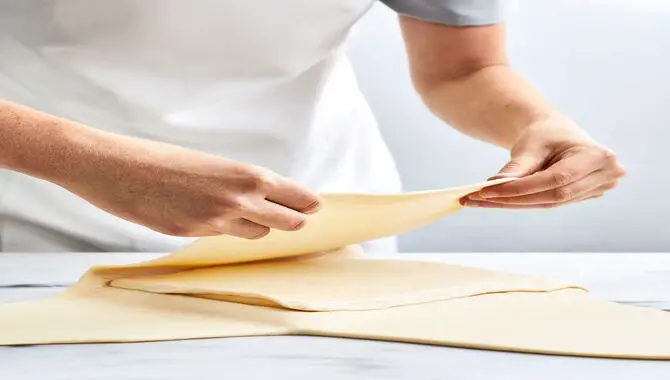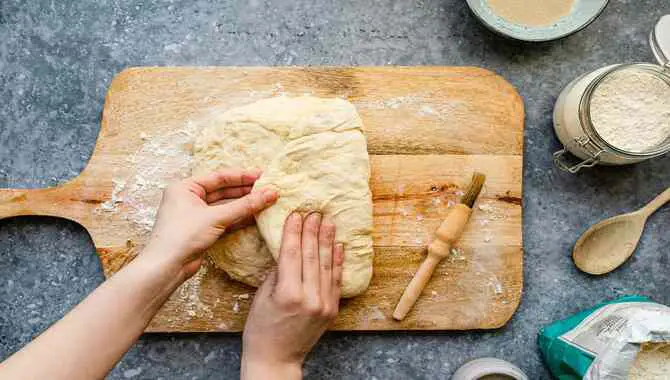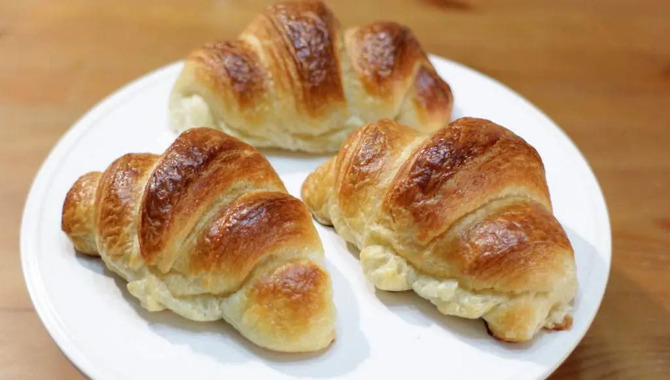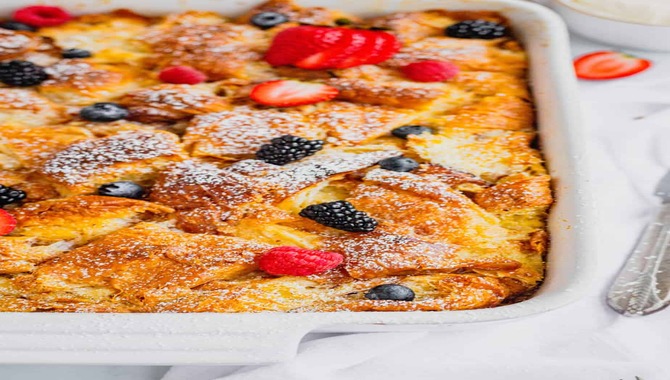Baking French croissants is a meticulous process that involves layering butter into the dough, rolling, folding, and chilling it multiple times.
The pastry is then shaped into crescents and baked until golden brown, resulting in a light, flaky, buttery treat ideal for breakfast or any time of day. The aroma of freshly baked French croissants is irresistible.
Here we will guide you through how to bake French croissants from scratch. We’ll even share tips on storing and reheating your homemade croissants so you can enjoy them anytime. Get ready to impress your friends and family with these delectable treats straight from your oven.

How To Bake French Croissants From Scratch – Full Process

Baking homemade croissants from scratch is a rewarding and mouthwatering experience every baker should try. You can achieve flaky and delicious French croissants with the precise combination of yeast, unsalted butter, flour, and other key ingredients. Below, we give you the full process of how to bake French croissants from scratch.
1. Gather The Necessary Ingredients
You will need a few essential ingredients to bake French croissants from scratch. Start with all-purpose flour, sugar, salt, active dry yeast, unsalted butter, and cold water. The quality of your ingredients is crucial for achieving a delicious and authentic taste, so opt for high-quality butter, preferably European-style butter with a higher fat content.
The cold water helps keep the butter solid during the dough folding, resulting in those flaky layers that make homemade croissants irresistible. Measure your ingredients accurately for the best results in your homemade croissants.
The yeast in the recipe is responsible for the croissants’ light and airy texture. Unsalted butter adds rich flavor and moisture to the dough, while cold water ensures that the butter stays solid and doesn’t melt too quickly during folding.
High-quality butter, such as European-style butter, with its higher fat content, will yield a more authentic and delicious result. By following the recipe and using these key ingredients, you can recreate the taste of flaky croissants typically found in French bakeries in the comfort of your kitchen.
2. Make The Detrempe Dough

To begin making French croissants from scratch, it is essential to create the degree dough. This dough is the foundation for the croissants, providing the base structure to build upon. Made from flour, water, salt, sugar, and yeast, the detrempe dough requires meticulous attention.
Start by kneading the dough until it reaches a smooth and elastic texture, thoroughly combining all the ingredients. Once the desired consistency is achieved, refrigerate the dough overnight or overnight. This chilling period serves multiple purposes, allowing the dough to rest and develop its flavor.
3. Create The Butter Block

To prepare the butter block for your homemade French croissants, begin by taking a block of unsalted butter and positioning it between two sheets of parchment paper. Use a rolling pin to flatten the butter into a rectangular shape gently. Next, fold the parchment paper over the butter, ensuring a tidy and secure package.
To firm up the butter block, refrigerate it for a minimum of 30 minutes. This chilled butter block will be vital in creating the delectably flaky layers of authentic French croissants. Incorporate this step into your croissant recipe for perfect results.
4. Laminate The Dough
To achieve the perfect flaky croissants, it’s essential to laminate the dough. This process involves repetitively folding and rolling out the dough with layers of cold butter. By doing so, you’re constructing those coveted flaky layers that make French croissants irresistible.
Start by rolling the dough into a long rectangle on a lightly floured surface. Next, place a chilled butter block on top of the dough, covering its entire surface. Fold the dough over the butter, sealing the edges to encapsulate the butter entirely.
Using a rolling pin, gently elongate the dough, maintaining its rectangular shape. Repeat this process several times, allowing the dough to chill in the refrigerator between each fold. The objective is to create multiple layers of butter and dough through lamination.
Laminating the dough demands accuracy and perseverance, yet the end outcome will be well worth the effort. Each fold generates thin layers of butter trapped within the dough, resulting in the delectable flakiness associated with French croissants.
5. Roll And Fold The Dough

Rolling and folding the dough is a crucial step in making French croissants. This process helps create the flaky texture characteristic of these delightful pastries. Roll out the dough into a rectangular shape on a lightly floured surface, ensuring its width and length precision.
Then, carefully fold one-third of the dough over the middle and the other third over to create three layers of dough and butter. Remember to rotate the dough 90 degrees after each fold to keep the layers even.
Place the dough in the fridge for an hour to let it rest and allow the gluten to relax. This resting period helps maintain the butter’s consistency and avoids potential melting. Once you’re done chilling the dough, take it out and roll it to your desired thickness.
Use a long ruler or a pizza cutter to cut the dough into triangles, ensuring their size is uniformly consistent. Proceed with cutting and shaping the croissants, progressing towards baking your homemade croissants to golden perfection.
6. Cut And Shape The Croissants
Creating the perfect homemade croissants involves two essential steps: laminating the dough and shaping the croissants. Laminating the dough is a crucial process that entails repeatedly folding and rolling out the dough with layers of butter.
This technique creates distinct layers in the croissant, resulting in its signature flaky and buttery texture. Start by rolling the dough into a rectangle and placing cold butter on top. Fold the dough over the butter, seal the edges, and roll it out again. Repeat this process, chilling the dough in between folds for optimal lamination.
Once the dough is properly laminated, it’s time to shape the croissants. Roll out the dough into a rectangle, fold one-third over the middle, then fold the remaining third to create three layers.
Rotate the dough 90 degrees and repeat the rolling and folding twice, chilling the dough between each fold. This process builds layers of butter and dough, essential for achieving the desired flakiness. After the final fold, roll the dough to the desired thickness and cut it into triangles.
7. Bake The Croissants
Follow these simple baking instructions for a foolproof way to create light and flaky homemade French croissants. Start gently rolling the dough into a long rectangle on a lightly floured work surface. Once rolled out, fold the dough into three layers, ensuring that each layer is evenly distributed.
Rotate the dough and repeat this rolling and folding process twice, chilling the dough between each fold. This technique, known as lamination, creates those desirable layers that make croissants so irresistibly flaky. Once the final fold is complete, roll the dough to your desired thickness and cut it into beautiful triangles.
Carefully shape each triangle into a crescent, placing them on a baking sheet lined with parchment paper. Preheat the oven and give the croissants an egg wash for that perfect glossy finish. Bake until golden brown, and enjoy the heavenly aroma wafting from your kitchen.
8. Add Finishing Touches
To put the finishing touches on your homemade croissants, follow these steps after your croissants have finished proofing. Preheating your oven to the required temperature, as mentioned in your croissant recipe. Before placing the croissants in the oven, create an egg wash by whisking together beaten eggs with a splash of milk or water. This mixture will give your croissants a glossy, golden finish.
Gently brush the egg wash onto the croissants, and for a little extra flavor and texture, sprinkle some sesame or poppy seeds on top. Carefully place the croissants in the preheated oven, and bake them until they have puffed up and turned a beautiful shade of golden brown, which usually takes 15-20 minutes. Remember to let the croissants cool slightly before indulging in their flaky goodness.
Enjoy Your Homemade Croissants

Creating your homemade croissants is a rewarding experience that allows you to savor the flaky, buttery pastries in the comfort of your home. With a little patience and practice, you can achieve perfect croissants that rival those from your favorite French bakeries.
The key to a successful croissant lies in the lamination process, which involves layering butter between layers of dough and folding it multiple times. You can enhance the flavor and texture of your homemade croissants by using high-quality ingredients, such as European-style butter.
Chilling the dough at various stages is important to allow the butter to solidify and create distinct layers when baked, resulting in that signature flakiness. Achieving the perfect croissant also requires precision in terms of temperature and timing in the oven. By following these steps, you can enjoy the delightful experience of baking and indulging in your homemade French croissants.
How To Store And Reheat French Croissants

To ensure your homemade French croissants stay fresh and delicious, it’s important to know how to store and reheat them properly. Storing croissants is simple – just place them in an airtight container at room temperature for up to 2 days. For longer storage, freeze the croissants in a freezer bag. When you’re ready to enjoy them again, remember to thaw them before reheating.
Reheating croissants is all about restoring their flaky texture. The best method is to place them in a preheated oven at 350°F for 5-10 minutes. This will give them a warm, crisp exterior.
If you’re short on time, you can also use a microwave for about 20 seconds but remember that they may not be as crispy as when reheated in the oven. Remember, proper storage and reheating techniques will help you enjoy your homemade croissants to the fullest!
Conclusion
baking French croissants from scratch is a labor of love that requires time, patience, and attention to detail. But the result is absolutely worth it – flaky, buttery, and delicious croissants that rival those from a French bakery. Whether you’re a seasoned baker or a novice in the kitchen, following these step-by-step instructions will ensure successful results.
Once you’ve mastered the art of making croissants, store any leftovers in an airtight container at room temperature for up to two days or freeze them for later enjoyment. To reheat, simply place the croissants in a preheated oven for a few minutes until warm and crispy. Hope the above outline on how to bake French croissants from scratch will be very helpful for you.
Frequently Asked Questions
What Is The Trick To Making A Perfect Croissant?
The secret to crafting a flawless croissant lies in the lamination technique, where layers of butter are folded and rolled into the dough. Chilling the dough adequately between each fold for those delightful flaky layers is essential.
What Is The Best Flour For French Croissants?
For the best French croissants, opt for high-protein flour like bread or all-purpose flour with a protein content of around 11-13%. Avoid low-protein flours such as cake flour, which won’t give you the desired texture.
What Is The Best Butter To Make Croissants?
Use European-style butter with higher fat and lower water content for the best croissants. Look for “cultured” or “European-style” labels. Popular brands like Plugrá, Kerrygold, and Lurpak are recommended for making delicious and flaky croissants.
What Flour Is Best For Croissants?
For the best croissants, use all-purpose flour with a protein content of around 11-12%. Avoid bread flour for a denser texture and cake flour for delicacy. Experiment with different brands to find your preferred flour.
What Happens If You Eggwash The Sides Of The Croissants?
Eggwashing the sides of croissants gives them a glossy, golden look and creates a crispy, flaky texture on the outer layers. It also adds a touch of richness and flavor. However, using just enough eggwash is important to avoid making the croissants heavy or soggy.

I’m a writer and blogger who loves to talk about entertainment, culture, and relationships. I love to share my thoughts and insights on these topics, and I’m always looking for new ways to engage with my readers. I’m also a big fan of learning new things, so I’m always exploring new areas of interest.
